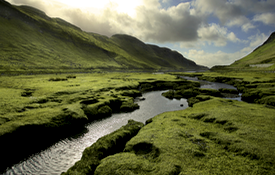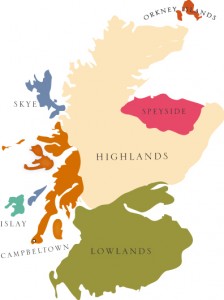
Scotland’s Whisky Regions
Scotland’s malt Whisky regions are a neat and tidy way of attempting to define style, but are these classic definitions still accurate or relevant?
Clearly the case of Lowlands malts and their tradition of triple distillation as opposed to double distillation common in the remainder of Scotland greatly impacts the malt Whiskies of the region. However, this is a choice and not an inescapable impact of being located within the region.
There are many factors that impact the resulting flavors of malt Whisky. Here are the top factors (in no particular order).
First is the malt itself and how it is fired or heated, and most significantly is peat used to fire these kilns. Every Whisky drinker, from novice to expert, can describe the impact of peated malt. At a time when almost every distillery malted their own barley, this sense of place was very pronounced. Today, most malt used in the production of malt Whisky is sourced from a handful of producers, evening out the unique impact of malt.
The second is water. Most Whisky distillers are located near an abundant local water source. These water sources are unique, possessing varying degrees of acidity, mineral content, and so on, and can be as unique as the Whiskies themselves. This water is used in the mash as the malted barley is converted into a sweet liquid to be fermented. Yeasts necessary for fermentation react to the water’s trace mineral makeup, as well as the pH and other factors. The water can come into play at the very end of the process when a water addition is made to bring the Whisky to a desired strength. The conclusion must be that water is a huge factor.
Third is the size and shape of the stills, which is, of course, a choice and has virtually nothing to do with any regional concern.
Fourth, and perhaps number one if these factors are to be ranked, is the choice of casks for aging. This greatly impacts the Whisky and will inevitably contribute to at least half of the Whisky’s flavor and aromatic profile.
Fifth is the choice of location for the maturation of the Whisky. Traditionally, the aging of the Whisky was done on-site, so the ambient temperature, smell of the air, and humidity were all great factors as the Whisky slumbered for a decade or more. Today, many distilleries age their casks of Whisky in warehouses far from their respective distilleries.
So what does this mean? Are Scotch Whisky’s regions impactful and relevant? Well, yes and no… (and becoming less so each year). The most important factor has been and will always be the style of the distillery (house style) shaped by the choices they have made regarding the five factors listed above.
Scotch Whisky Traditional Regions

Mapping Scotch Whisky Regions
Lowlands – A large area starting on Scotland’s Southern border with England and to the north by an imaginary line from Greenock on the west to Dundee in the east. This region includes Scotland’s two largest cities, Glasgow and Edinburgh. Lowland malts were traditionally triple distilled as opposed to double distilled, as used by all other Scotch malt distillers. Lowland malts are lighter in colour and body being generally floral with a dry finish.
Highlands – The largest region and best understood by dividing into five sub-regions. The most important sub-region is Speyside, which is home to roughly half of Scotland’s working malt distilleries. Speyside malts are characterized as being fruity, sweet, and complex with an unmistakable elegance. Obviously, with so many malt distilleries occupying this space near the River Spey properly identifying a regional style is all but impossible. Many of Scotland’s biggest names reside here, including the two biggest global sellers: The Glenlivet and Glenfiddich.
Northern Highlands tend to be the sturdiest and most rustic malts, showing hints of the sea. The Southern Highlands tend to be lighter than other Highland malts with fragrant herbal notes. The sea greatly affects the Western Highland malts, often peat-influenced and substantial. The Eastern Highland malts border Speyside and stylistically fall between Speyside and Northern malts, with some, like Ardmore, showing rustic peat influences.
The Islands – Among the Whisky producing islands Islay is by far the most important, being home to nine active distilleries. Islay is part of the Inner Hebridean Islands just off the Western coast of Scotland’s mainland. Islay malts are often pungent (but not always), full-bodied, peaty, and appreciably touched by the sea. All of the active nine have their own unique style.
Other isles on the Western coast include Jura, Mull, Arran, and Skye. Each island hosts a single distillery, while Orkney, the furthestmost island, is home to two distilleries.
Campbeltown – A dangling peninsula on the Western coast is now home to just three distilleries, including the famous Springbank. Campbeltown was once the most important malt Whisky region in Scotland, home to dozens of distilleries earning the moniker “Whisky capital of the world.”
Don’t miss our – Mastering Scotch Whisky feature.
Get our BevX Scotch Whisky Basics Infographic

Great read!